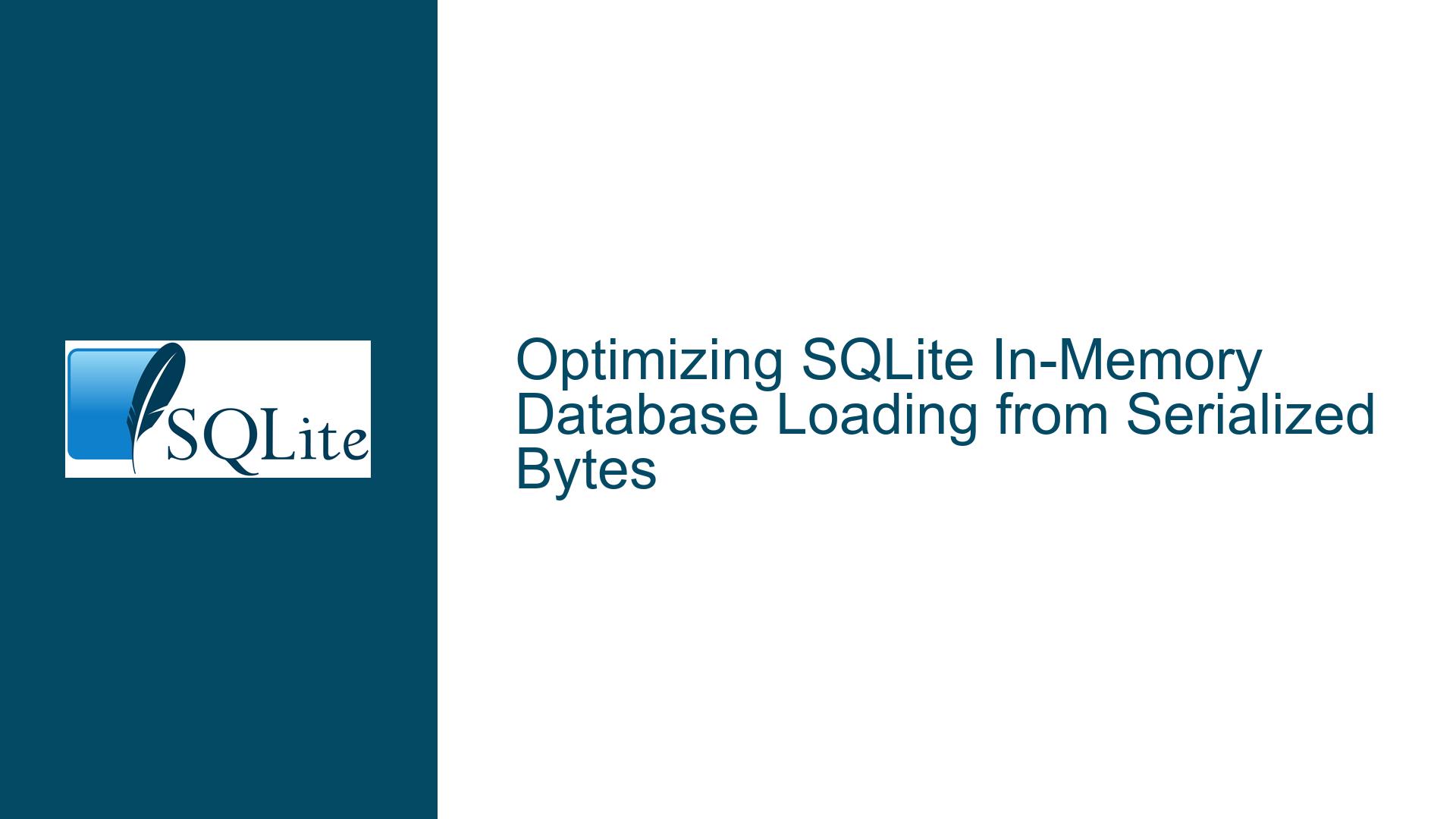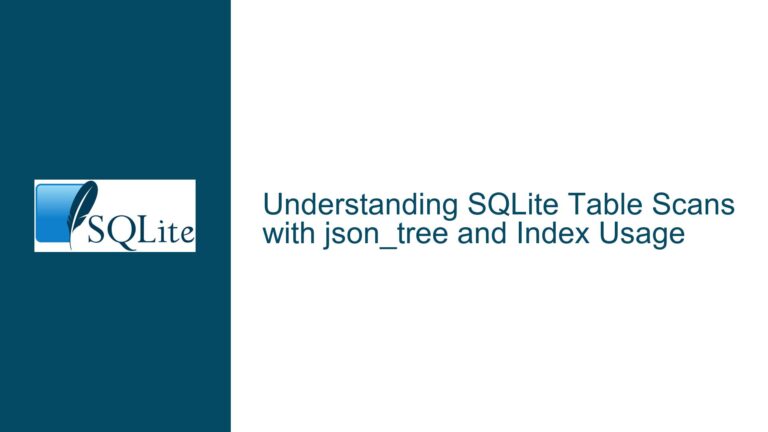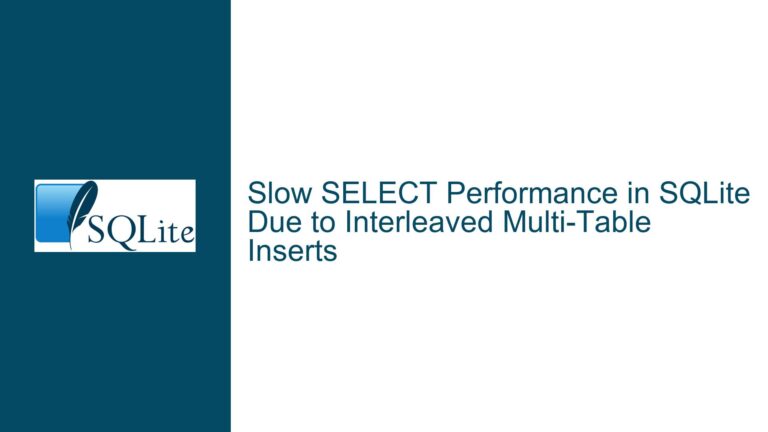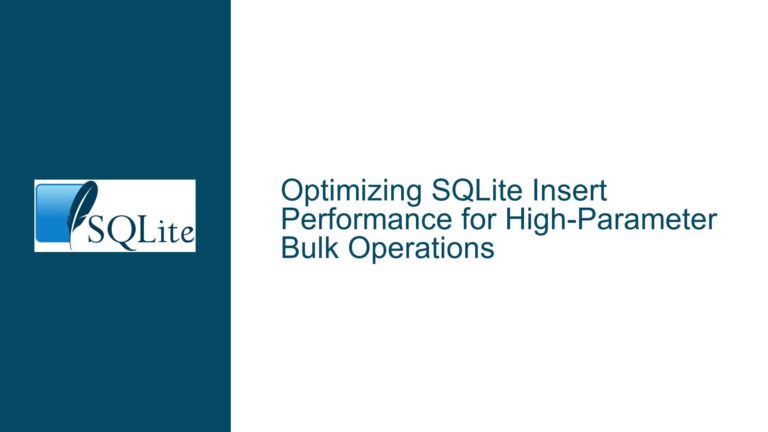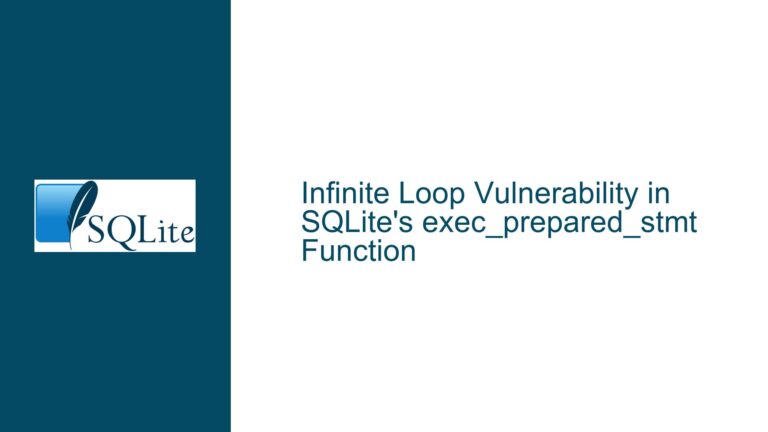Optimizing SQLite In-Memory Database Loading from Serialized Bytes
Serialized SQLite Database Bytes and In-Memory Loading Challenges
When working with SQLite databases, particularly in environments where performance and resource efficiency are critical, the ability to load a database directly into memory from serialized bytes can be a game-changer. This approach avoids the overhead of writing to and reading from physical storage, which can be a significant bottleneck in high-frequency or resource-constrained scenarios. However, the process of deserializing a SQLite database from bytes into an in-memory database is not always straightforward, especially when dealing with platform-independent systems and limited server control.
The core issue revolves around the need to load a SQLite database into memory directly from a serialized byte stream, bypassing the traditional file I/O operations. This is particularly relevant in server environments where the database is received as a byte stream over a network and needs to be processed quickly without the latency introduced by disk operations. The challenge is to ensure that the in-memory database is both accurate and efficient, maintaining the integrity of the data while minimizing resource usage.
Serialization and Deserialization APIs in SQLite
SQLite provides robust APIs for serializing and deserializing databases, which are essential for transferring databases between different systems or loading them into memory. The sqlite3_serialize function allows you to convert a database into a byte stream, which can then be transmitted or stored. Conversely, the sqlite3_deserialize function is used to convert this byte stream back into a database in memory. These functions are particularly useful in scenarios where the database needs to be moved between different environments or loaded quickly without the overhead of file I/O.
However, the deserialization process is not always intuitive, especially when dealing with complex data structures or large databases. The byte stream must be correctly formatted and compatible with the SQLite version being used. Additionally, the memory allocation and management during deserialization must be handled carefully to avoid issues such as memory leaks or corruption. Understanding the nuances of these APIs is crucial for implementing an efficient and reliable in-memory database loading mechanism.
Implementing Efficient In-Memory Database Loading
To implement an efficient in-memory database loading mechanism, it is essential to follow a structured approach that ensures data integrity and performance. The first step is to ensure that the serialized byte stream is correctly formatted and compatible with the SQLite version being used. This involves verifying the byte stream’s integrity and ensuring that it contains all the necessary data structures and metadata required by SQLite.
Once the byte stream is verified, the next step is to use the sqlite3_deserialize function to load the database into memory. This function requires careful handling of memory allocation and management to avoid issues such as memory leaks or corruption. It is also important to ensure that the database is correctly initialized and that all necessary configurations, such as journal modes and locking mechanisms, are set up correctly.
Finally, it is crucial to monitor the performance and resource usage of the in-memory database to ensure that it meets the required performance criteria. This involves profiling the database operations and optimizing the memory usage to minimize the impact on the system. By following these steps, you can implement an efficient and reliable in-memory database loading mechanism that meets the needs of your application.
Detailed Troubleshooting Steps and Solutions
Verifying the Serialized Byte Stream
Before attempting to deserialize the database, it is essential to verify that the serialized byte stream is correctly formatted and compatible with the SQLite version being used. This involves checking the byte stream’s integrity and ensuring that it contains all the necessary data structures and metadata required by SQLite. One way to do this is to use a checksum or hash function to verify the integrity of the byte stream. Additionally, you can use tools such as sqlite3_analyzer to inspect the byte stream and ensure that it contains all the necessary components.
Using the sqlite3_deserialize Function
The sqlite3_deserialize function is used to load the database into memory from the serialized byte stream. This function requires careful handling of memory allocation and management to avoid issues such as memory leaks or corruption. When using this function, it is important to ensure that the memory allocated for the database is sufficient and that it is correctly aligned. Additionally, you should ensure that the database is correctly initialized and that all necessary configurations, such as journal modes and locking mechanisms, are set up correctly.
Monitoring Performance and Resource Usage
Once the database is loaded into memory, it is crucial to monitor its performance and resource usage to ensure that it meets the required performance criteria. This involves profiling the database operations and optimizing the memory usage to minimize the impact on the system. You can use tools such as sqlite3_status to monitor the database’s memory usage and performance. Additionally, you should regularly check for memory leaks and other issues that could affect the database’s performance and stability.
Handling Platform and OS Independence
In environments where the system is platform and OS independent, it is important to ensure that the in-memory database loading mechanism is compatible with all supported platforms and operating systems. This involves testing the mechanism on different platforms and ensuring that it works correctly in all scenarios. Additionally, you should ensure that the memory allocation and management functions used are compatible with all supported platforms and operating systems.
Optimizing Memory Usage
Optimizing memory usage is crucial for ensuring that the in-memory database loading mechanism is efficient and does not impact the system’s performance. This involves carefully managing the memory allocated for the database and ensuring that it is used efficiently. You can use techniques such as memory pooling and garbage collection to optimize memory usage and minimize the impact on the system. Additionally, you should regularly monitor the database’s memory usage and adjust the memory allocation as needed to ensure optimal performance.
Ensuring Data Integrity
Ensuring data integrity is crucial for maintaining the accuracy and reliability of the in-memory database. This involves implementing robust error handling and recovery mechanisms to ensure that the database can recover from errors and continue to operate correctly. Additionally, you should regularly back up the database and verify its integrity to ensure that it is not corrupted or damaged. By following these steps, you can ensure that the in-memory database loading mechanism is reliable and maintains the integrity of the data.
Implementing Journal Modes and Locking Mechanisms
Implementing journal modes and locking mechanisms is crucial for ensuring that the in-memory database is correctly initialized and configured. Journal modes such as WAL (Write-Ahead Logging) can improve the performance and reliability of the database by reducing the number of write operations and ensuring that the database can recover from crashes or errors. Additionally, locking mechanisms such as EXCLUSIVE or NORMAL can help to prevent conflicts and ensure that the database operates correctly in multi-threaded or multi-process environments.
Profiling and Optimizing Database Operations
Profiling and optimizing database operations is crucial for ensuring that the in-memory database meets the required performance criteria. This involves using tools such as sqlite3_profile to monitor the database’s performance and identify any bottlenecks or issues that could affect its performance. Additionally, you should regularly optimize the database’s queries and operations to ensure that they are efficient and do not impact the system’s performance. By following these steps, you can ensure that the in-memory database loading mechanism is efficient and meets the needs of your application.
Handling Large Databases
Handling large databases in memory can be challenging, especially in resource-constrained environments. This involves carefully managing the memory allocated for the database and ensuring that it is used efficiently. You can use techniques such as memory pooling and garbage collection to optimize memory usage and minimize the impact on the system. Additionally, you should regularly monitor the database’s memory usage and adjust the memory allocation as needed to ensure optimal performance. By following these steps, you can ensure that the in-memory database loading mechanism is efficient and meets the needs of your application.
Ensuring Compatibility with Different SQLite Versions
Ensuring compatibility with different SQLite versions is crucial for maintaining the reliability and stability of the in-memory database loading mechanism. This involves testing the mechanism with different SQLite versions and ensuring that it works correctly in all scenarios. Additionally, you should ensure that the serialized byte stream is compatible with all supported SQLite versions and that the deserialization process is correctly implemented. By following these steps, you can ensure that the in-memory database loading mechanism is reliable and maintains the integrity of the data.
Implementing Robust Error Handling and Recovery Mechanisms
Implementing robust error handling and recovery mechanisms is crucial for ensuring that the in-memory database can recover from errors and continue to operate correctly. This involves implementing error handling and recovery mechanisms that can detect and recover from errors such as memory leaks, corruption, or crashes. Additionally, you should regularly back up the database and verify its integrity to ensure that it is not corrupted or damaged. By following these steps, you can ensure that the in-memory database loading mechanism is reliable and maintains the integrity of the data.
Optimizing Network Transfer and Serialization
Optimizing network transfer and serialization is crucial for ensuring that the in-memory database loading mechanism is efficient and does not impact the system’s performance. This involves optimizing the serialization process to ensure that the byte stream is as small as possible and that it can be transferred quickly over the network. Additionally, you should ensure that the network transfer process is efficient and that it does not introduce any latency or bottlenecks. By following these steps, you can ensure that the in-memory database loading mechanism is efficient and meets the needs of your application.
Ensuring Security and Data Privacy
Ensuring security and data privacy is crucial for maintaining the confidentiality and integrity of the in-memory database. This involves implementing robust security measures such as encryption and access control to ensure that the database is protected from unauthorized access or tampering. Additionally, you should ensure that the serialized byte stream is encrypted and that it can only be decrypted by authorized parties. By following these steps, you can ensure that the in-memory database
